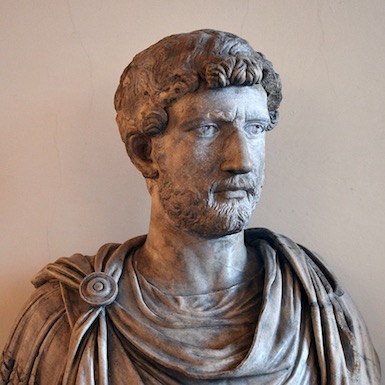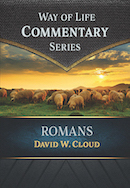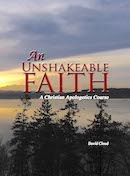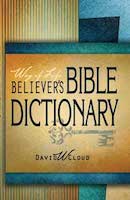866-295-4143, fbns@wayoflife.org

Marble bust of Hadrian at the Venice
National Archaeological Museum
Called the Bar Kokhba revolt, it was led by Simon ben Kosiba.
The occasion of the Bar Kokhba revolt was Emperor Hadrian’s (Publius Aelius Hadrianus) (r. 117-138) plan to build a Roman city over the ruins of Jerusalem. After its destruction in AD 70, it had not been rebuilt.
“This was typical Roman behavior: in previous ages Carthage had been razed and years passed before reoccupancy of the site was allowed. A similar fate had befallen Corinth” (Anthony Everitt, Hadrian and the Triumph of Rome).
Hadrian became emperor in AD 117, following Trajan. A gold coin struck to celebrate the occasion depicts Trajan handing a globe to Hadrian, “signifying the transfer of the rulership of the world.” Here we see that the ancient Romans knew that the world is round and not flat!
In AD 130, Hadrian visited Judea on his way to Egypt and announced his decision to erase the memory of Israel and Jehovah God from Jerusalem and make it an idolatrous Roman city in his own honor. He renamed Jerusalem Aelia Capitolina. Aelia is derived from Hadrian’s family name Aelius, and Capitolina refers to the idolatrous cult of the Capitoline Triad in Rome (Jupiter, Juno, and Minerva).
Hadrian erected a temple of the filthy god Jupiter on the Temple Mount. (Earlier he built the famous Olympian Jupiter temple in Athens.) The Roman Jupiter was the Greek Zeus. According to Greek mythology, Zeus was married to his sister Hera and he was an infamous adulterer. Many of the myths pertain to Hera’s attempt to get revenge against Jupiter for his infidelities. He also joined his brother Poseidon and Hades to commit the fratricide of their father Cronus.
Hadrian also raised up a blasphemous memorial to his own deification in the form of an equestrian statue which he placed over the former location of the Jewish temple’s Holy of Holies.
Hadrian built a temple of Venus (Aphrodite), the “goddess of love,” over Christ’s empty tomb. Since this was only about 40 years after the death of the Apostle John, it seems certain that the site of the original tomb site was then known. (About two hundred years later, the emperor Constantine razed the pagan temple and built the Church of the Holy Sepulcher over the same site, which is why we believe that this church is located on Christ’s burial site. For a pictorial study of this see Bible Times & Ancient Kingdoms, PowerPoint # 24, “Christ’s Passion Week,” available from Way of Life Literature.)
Hadrian loved participating in orgies at idolatrous festivals and was deeply involved in witchcraft and occultic ceremonies. He traveled to Greece to be initiated into the secret Mysteries of Eleusis, which was supposed to bring great blessing and “ensure a prosperous posthumous future.” The mysteries were founded on the myth of the death and rebirth of Persephone, daughter of the fertility goddess Demeter. The process began with the sacrifice of a pig to Demeter. During the ensuing ceremonies, a crowd of initiates danced themselves “into a state of euphoria.” The finale was conducted in a dark, windowless temple called Telesterion, or hall of mysteries. It ended with the opening of the door and the shining of a great light, signifying the new birth and the entrance into spiritual wisdom. Like the Egyptian myth of Osiris and Isis, the Greek Mysteries of Eleusis were a cheap demonic substitute for the incarnation, atonement, and resurrection of Christ and the gospel of salvation by faith in Him. The ancient pagan mysteries were available only to select initiates, who were sworn to perpetual secrecy, on pain of death, but the gospel of Jesus Christ is available to all who believe and is to be preached to all nations.
Hadrian infamously lived with a young male partner named Antinous. In his extensive travels, he made a point of attending idolatrous orgies, such as the festival of Erotidia in Boeotia in Greece. Dedicated to the god Eros, son of Aphrodite, it celebrated every form of moral perversion. When Antinous drowned under suspicious circumstances in the river Nile during Hadrian’s visit to Egypt (after he left Judea), Hadrian had him deified as a god and erected statues of him throughout the empire. (Trajan, who preceded Hadrian, was also a homosexual.) “One of the remarkable features of this period is that for nearly fifty years the imperial government was headed by two men who engaged predominantly, if not exclusively, in homosexual behavior,” Everitt, Hadrian and the Triumph of Rome).
Hadrian had multitudes of people tortured and killed and cruelly sold as slaves, such as the more than half million Jews that were slaughtered during the Bar Kokhba revolt, but he loved his pet animals. He built elaborate tombs for his horses and dogs. When his favorite horse, Borysthenes, died, he wrote a poem as an epitaph.
Hadrian built one of the largest and most elaborate private palace complexes in history. The 250-acre villa, located at Tibur, a short distance from Rome, could house 2,000 guests and attendants. It was garishly colorful, decorated with “frescoes and marble of every hue, and bright mosaics covering the floor.” The ever-present statues were painted in brilliant colors. The buildings were constructed with the rarest and most beautiful marble and wood. Water flowed throughout the huge villa. “It spurted, fell, or flowed in monumental fountains, ran along sluices, or stood still and glassy in rectangular pools” (Everitt). The villa was reached by a 250-yard chariot road skirted by a colonnaded terrace.
Returning to Hadrian’s rebuilding of Jerusalem as Aelia Capitolina, the city featured a 40-foot-wide colonnaded Maximus Cardo (a main north-south boulevard) running from the Damascus Gate to the Zion Gate. (An east-west boulevard was called a Decumanus.) A Roman cardo usually had covered walkways and shops along the sides. A portion of Jerusalem’s cardo was excavated in 1969 and can be seen today in the Jewish Quarter of the Old City.
Shrines were built at Caesarea and Tiberius in praise of Hadrian, and a Hadrianic festival was founded at Gaza.
Hadrian minted a coin in about 130-132 that depicts him driving a team of bulls to plow up Jerusalem. The inscription reads, “Colonia Aelia Kapitolina Condita” (“the founding of Colonia Aelia Capitolina”).
How dramatically was the prophecy of Micah fulfilled!
“Therefore shall Zion for your sake be plowed as a field, and Jerusalem shall become heaps, and the mountain of the house as the high places of the forest” (Mic. 3:12).
In 2014, the Israel Antiquities Authority found a stone fragment engraved with an inscription to Hadrian by the Roman 10th legion. Dating to his visit in AD 130, it reads,
“To the Imperator Caesar Traianus Hadrianus Augustus, son of the deified Traianus Parthicus, grandson of the deified Nerva, high priest, invested with tribunician power for the 14th time, consul for the third time, father of the country [dedicated by] the Tenth Legion Fretensis Antoniniana.”
A couple of years after Hadrian’s visit to Judea and his decision to build Aelia Capitolina, SIMON BAR KOSIBA announced himself as the prince and Messiah to restore Israel’s temple and kingdom. He signed his letters “prince of Israel” (Anthony Everitt, Hadrian and the Triumph of Rome).
Bar Kosiba was pronounced the Messiah by prominent rabbi Akiva ben Yosef, a major contributor to the Talmud. Believing that Simon would defeat Rome and restore the temple in Jerusalem, Akiva declared him Simon bar Kochba or Son of the Star, referring to the Messianic prophecy of Numbers 24:17.
“... there shall come a Star out of Jacob, and a Sceptre shall arise out of Israel...”
Bar Kosiba raised a ragtag Jewish army of 200,000. For concealment, they built hundreds of cave and tunnel complexes with ventilation shafts, water and food supplies. Archaeologists have found more than 300 of these.
According to the Talmud, Bar Kosiba required recruits to prove their valor and devotion by chopping off a finger. Before going into battle, he reportedly said, “O Master of the universe, there is no need for you to assist us, but do not embarrass us either!” (Palestinian Talmud, Ta’anit 4:5).
Bar Kosiba was thus a worthy fulfillment of Zechariah’s prophecy of a “foolish shepherd” (Zec. 11:15). After describing Israel’s rejection of Christ and betrayal for 30 pieces of silver, the prophet mentions a foolish shepherd who will be received by blind Israel. Christ prophesied of one “who shall come in his own name, him ye will receive” (Joh. 5:43).
Bar Kosiba is one of many foolish shepherds that Israel has followed since she rejected the Good Shepherd. The ultimate foolish shepherd will be the Antichrist of the last days.
The Bar Kokhba revolt was successful initially. They defeated two Roman legions and captured 50 strongholds. Many thought that the liberation of Israel was at hand.
Coins were inscribed with the words “to the freedom of Jerusalem.”
The coins featured images pertaining to the temple, as there were Jews still living who had seen the Second Temple with their own eyes.
Some images depicted the facade of Herod’s Temple with its four pillars and arched door.
Others depicted the silver trumpets.
“Make thee two trumpets of silver; of a whole piece shalt thou make them: that thou mayest use them for the calling of the assembly, and for the journeying of the camps” (Numbers 10:2).
The Jews hoped that the trumpets would soon sound from a Third Temple.
Other Bar Kokhba coins depicted the harp or lyre.
“Praise the LORD with harp: sing unto him with the psaltery and an instrument of ten strings” (Psalm 33:2).
This harp has been called the Davidic harp. Its body is shaped to fit comfortably into the crook of the arm. It has been reconstructed by people associated with the Temple Institute who are preparing to build the Third Temple.
Some Bar Kokha coins featured a star above the temple, depicting the coming of the Messiah as the “Star of Jacob.”
As we will see in the sections “Israel Present” and “Israel Future,” Israel is still looking for a temple builder, whether prophet or messiah, and the Temple Institute is preparing articles for the Third Temple. These include the menorah (made from three million dollars worth of gold), the garments for the priests and the high priest, the table of shewbread, the laver, and the table of incense.
The problem is that they have already rejected the Messiah in the person of Jesus!
Justin Martyr and Jerome stated that Bar Kokhba required that Christians deny Jesus as the Messiah and blaspheme Him, and those who refused were severely punished. They were “murdered with every sort of torture.” Christian writers referred to Bar Kokhba as “a butcher, a bandit, and a con man.”
The Emperor Hadrian was enraged at the rebellion and sent some of his best generals (Julius Severus and Tineius Rufus) with 12 legions (one-third of the Roman army) to put it down. In fact, it appears that Hadrian returned to Judea and led the campaign himself for a short period (Anthony Everitt, Hadrian and the Triumph of Rome, Kindle Loc. 5213).
In AD 135, the Bar Kokhba insurrection was finished. It ended with the fall of Bethar (Beitar), the Jewish rebel capital and the last fortress to hold out against the legions. It was located about seven miles southwest of Jerusalem in the Judean mountains. The Roman legions besieged the fortress and built a wall around it to trap its defenders. Bethar was captured on the 9th of Av, the same day that the first and second temples had fallen. Thousands of Jews had fled to Bethar and every one was slaughtered. The Romans did not allow the burial of the bodies for six days. Archaeological excavations found remnants of a defensive curtain wall and nine towers, Roman camps, sling stones, arrowheads, and a Latin inscription describing the participation of two legions in the siege: V Macedonica and XI Claudia.
During and after the insurrection, hundreds of thousands of Jews were killed. The Roman historian Cassius Dio gave the figure of 580,000. Many starved to death. Tens of thousands were sold as slaves and carried away to other nations. “So many Jews were sold as slaves that the price of a slave was the same as the price of one day’s supply of hay for a horse” (“Aelia Capitolina,” www.biu.ac.il).
Judea was reduced to rubble, with 50 fortified towns and nearly 1,000 villages razed.
Hadrian executed most of the Sanhedrin leaders and Torah scholars, including Rabbi Akiva, Simon ben Kosiba’s most prominent supporter. According to the historian Eusebius, Akiva was skinned alive.
Embittered Jewish survivors of this holocaust renamed Simon bar Kokhba Simon bar Kozeba (Son of the Lie).
Hadrian tried to erase the very memory of Israel. He made decrees against Torah study, the possession of Scripture, Sabbath keeping, circumcision, and synagogue worship. Scripture scrolls were burned. Synagogues were wrecked. Jews were forbidden to visit Jerusalem except once a year on the day of the destruction of the Temple.
In addition to renaming Jerusalem, Hadrian renamed the land of Judea “Syria Palestina.”
Hadrian was so thrilled with the destruction of Judea that he bestowed Severus and two other generals triumphal honors (ornamenta triumphalia), Rome’s highest military award.
Hadrian died in the summer of 138, only six years after the Bar Kokhba revolt, after a long and painful illness. His idolatrous rituals and witchcraft could not save him. His suffering was so great that he tried to commit suicide, though unsuccessfully, and begged to be euthanized.
Hadrian’s body was interred in a splendid tomb and an effigy was cremated on a “tall, richly decorated multistory pyre.” When the fire was started a caged eagle at the top was released, “which signified Hadrian’s spirit flying up through the flames to join the immortal gods.”
But there is evidence that Hadrian knew that he was not going to join “the immortal gods.” During his final illness, he wrote a poem to his own soul:
Little soul, you charming little wanderer,
my body’s guest and partner,
where are you off to now?
Somewhere without color, savage and bare;
you’ll crack no more of your jokes once you’re there.
(Anthony Everitt, Hadrian and the Triumph of Rome, Kindle Loc. 5529).
It seems that Hadrian knew that his soul was going to hell, in spite of the promise of the Mysteries of Eleusis, though he didn’t know the true horror of the place. Savage and bare and humorless, indeed!
Hadrian had no excuse for his idolatry and blasphemy. He had the light of creation and conscience, and he had ready access to the light of Scripture. He was the only Roman emperor to visit Israel during office, and he could have read the Old Testament Scriptures in a Greek translation or had someone translate it into Latin. Perhaps he did.
Better, he could have read the New Testament Scriptures. Hadrian knew of Jesus Christ and the resurrection claims and could have interviewed men and women who personally knew eyewitnesses of the resurrected Christ. For example, Polycarp lived from AD 69-155 and wrote in defense of Christ’s resurrection, and Polycarp personally knew the apostle John.
Hadrian had every opportunity to pursue the truth of God’s Word. Instead he demanded that Jews and Christians worship the Caesars, killed those who refused, burned the Scriptures, erected a statue of himself over the place of Jehovah’s Holy of Holies, constructed a pagan temple over Christ’s empty tomb, tried to obliterate the memory of Israel, and died in his vile idolatry.
Rome was the powerful kingdom of iron of Daniel 2 and the “exceeding dreadful” fourth kingdom of Daniel 7:19. The latter prophecy describes Rome as a beast with teeth of iron and nails of brass, “which devoured, and brake in pieces, and stamped the residue with his feet.” What a perfect description of Rome’s attempt to destroy Israel as a people and to erase her very memory from her own land and capital city! Rome did her best to destroy both Israel and Christianity but was singularly unsuccessful in both cases.
The proud Caesars are long gone and their splendor lies in the dust, but Israel still exists, and this is in fulfillment of Bible prophecy!
The past 2,500 years of Israel’s history is irrefutable evidence of the divine inspiration of the Bible, because the history of these times was recorded plainly in Bible prophecy in Deuteronomy 28-30 a millennium before the Babylonian Captivity of 586 BC.
- Receive these reports by email
- www.wayoflife.org
______________________
Sharing Policy: Much of our material is available for free, such as the hundreds of articles at the Way of Life web site. Other items we sell to help fund our expensive literature and foreign church planting ministries. Way of Life's content falls into two categories: sharable and non-sharable. Things that we encourage you to share include the audio sermons, O Timothy magazine, FBIS articles, and the free eVideos and free eBooks. You are welcome to make copies of these at your own expense and share them with friends and family. You may also post parts of reports and/or entire reports to websites, blogs, etc as long as you give proper credit (citation). A link to the original report is very much appreciated as the reports are frequently updated and/or expanded. Things we do not want copied and distributed are "Store" items like the Fundamental Baptist Digital Library, print editions of our books, electronic editions of the books that we sell, the videos that we sell, etc. The items have taken years to produce at enormous expense in time and money, and we use the income from sales to help fund the ministry. We trust that your Christian honesty will preserve the integrity of this policy. "For the scripture saith, Thou shalt not muzzle the ox that treadeth out the corn. And, The labourer is worthy of his reward" (1 Timothy 5:18). Questions? support@wayoflife.org
Goal:Distributed by Way of Life Literature Inc., the Fundamental Baptist Information Service is an e-mail posting for Bible-believing Christians. Established in 1974, Way of Life Literature is a fundamental Baptist preaching and publishing ministry based in Bethel Baptist Church, London, Ontario, of which Wilbert Unger is the founding Pastor. Brother Cloud lives in South Asia where he has been a church planting missionary since 1979. Our primary goal with the FBIS is to provide material to assist preachers in the edification and protection of the churches.
Offering: Offerings are welcome if you care to make one. If you have been helped and/or blessed by our material offerings can be mailed or made online with with Visa, Mastercard, Discover, or Paypal. For information see: www.wayoflife.org/about/makeanoffering.html.





